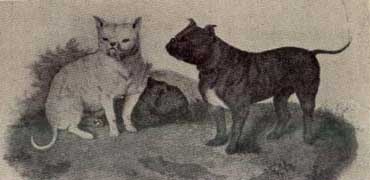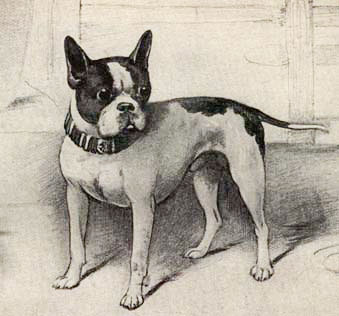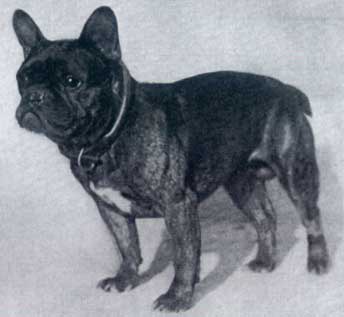The remote past of French Bulldog
The French Bulldog is a miniature hunting Molossian. The Molosians as such, and not only the hunting varieties, are spread over all five continents. Borders and frontiers abound, but not breeds of dogs. Throughout human history, almost all peoples have sailed from one place to another, and with them, they took their hunting Molosians. What happened when they reached port is well known.
In ancient Britain, the Celtic peoples had enormous dogs which they used in the battle against the frequent invaders, for example, the Romans, who knew well the "pugnace britannicii", and were the first to test the mettle of this breed of dog.
If we jump ahead a few centuries, we find that in the middle ages the English nobility hunted with their huge Mastiffs also realizing that beef had a superior flavor if the bulls were made to exercise before being sacrificed. In this way began the practice of using large dogs to harass the bulls. But they did not permit the common people to possess big dogs and imposed their "Laws of the Woodland" in 1272. The penalties for transgressors were harsh.
 |
| English Bulldog 1800 |
But with typical astuteness, the common people began to develop a smaller Mastiff, as strong and as ferocious as its bigger cousin, but with shorter legs. This later gave rise to the English Bulldog, a vital link to what would become the French Bulldog. The Bulldog over the years became the emblem of the English.
The word bulldog appears for the first time in 1632 in a letter written from San Sebastian in Spain by Mr. P. Eaton to Wellingham, then living in London, in which he asks to be sent " a good Mastire dog, a case of liquor and I beg you to get for me some good bulldogs".
Combats between bulls and Bulldogs enjoyed popularity in the early and late middle ages. Queen Elizabeth, I was a great admirer of these fights. There were, however, even in those times, those who felt that this spectacle was cruel and senseless, and in 1835 these events were fortunately outlawed by William IV
But what was to be done with the dogs? This ferocious and combative breed no longer provided a source of income for their owners and was hardly a domestic pet.
Once again the law of reduced dimensions came into play. Some breeders began to select smaller dogs. But this smaller dog was not to the liking of all breeders of Bulldogs. One only has to think of the amounts of money involved in dogfights which, although expressly prohibited, were, and are, held in secret.
The smaller bulldog could not provide the same degree of excitement and spectacle as his bigger ancestor, not for want of courage it must be said. And so the Bulldog gradually ceased to be a fighting dog and indeed it almost disappeared. In 1860 in Birmingham, in the English midlands, we see the first appearance of a dog that we would recognize as the English Bulldog as we know him today.
The early 19th century
In the early 19th century we come to a point of crisis for the bulldog. We have a breed of dog whose character must be in some way pacified ( given that it is no longer to be used as a fighting dog) so that it may be kept either as a pet or guard dog in the home. Perhaps both?
It seems that the small Pug played an important part in this development of the dog's diplomatic posture. The failed experiments were discarded. But is it possible that some of these "failures" were sold at a lower price? Did some of these dogs find their way into the hands of members of the lower classes?
The purists, we know, disdained these "degraded " examples of the national symbol. So from this point on we find that effectively there are two types of "Bulldog" living almost side by side; the English Bulldog and the English Toy Bulldog. From the latter, we get the modern French Bulldog.
The Industrial Revolution
For reasons that are not altogether clear ( although we may speculate), the Toy Bulldog became very popular amongst the workers in the Nottingham lace industry in the midland region.
The many economic crises of the 19th century and the industrial production of textiles made life very difficult for the artisan producer. One of the results was that many of the lace workers of Nottingham moved to France, specifically to the Calais area.
They took with them their small bulldog with its characteristic shell ear. This small bulldog interbred with the native "terrier boule" ( not to be confused with the Bull Terrier) which were in the hands of butchers and other meat trade workers in the abbatoir of De Villette in Paris, eventually giving rise to the French Bulldog.
A little later the coach drivers, shoemakers, street traders, and even the police became fans of the "petit Boule". It soon became the star of working-class Parisian society. Its physique, small size, peculiar physiognomy, and enchanting personality made it the darling of lovers of flat-faced dogs. It was also the star of the women who frequented the public houses of the day, where "Les Filletes de la Belle Epoque" kept it for its excentric appearance.
Napoleon and top hat
 |
Napoleon and top hat |
End of the 19th century
It was during this period that the upper classes, through their coachmen and bordellos, began to discover and fall under the charm of this small dog with its persuasive and at times disturbing look. Immortalized by Toulouse Lautrec in his picture "Le Marchand des Marrons" (1897) the French Bulldog strode the Boulevards. Mistinguett, Colette, Mac Orland, King Edward VII with his dog Peter in England, were some of the more notable fans of the breed.
When the remains of the Romanoff family were discovered some years ago in Russia, Princess Tatiana's remains were found together with the skeleton of her dog, Ortino. In Austria, Germany, and of course the USA the breed began to acquire more and more popularity.
 |
| Le Marchand des Marrons |
The French Bulldog's success really began in 1880 however, when a group of Parisian Frenchy breeders and fans began to organize regular weekly meetings. In 1885 the first provisional register of the breed was established and the French Bulldog participated in an exhibition under its own name for the first time in 1887.
The following year the club was formally constituted with Marcel Roger, a great admirer of the breed, as founding president. However, it was to be another ten years before the French Canine Society began to take the breed seriously. This happened when the Central French Canine Society suggested that the society formed by Gordon Bennet ( the French Bulldog Lovers' Club) and Marcel Roger's aforementioned club join forces.
Both parties saw the sense in this union and so the Bouledoge Club of France as we know it today came into being. The president was Menans de Corre and the vice president Gordon Bennett.
Turn of the century England on the ward
And what was happening in England meanwhile? When the French Bulldog appeared in England in 1898 it caused a genuine scandal in the English media.
One can read in the specialist press of the day, " We English, who have always felt a special affinity for our national symbol, must reject this little abomination that has been brought to our country, even though it be called French Bulldog".
It is difficult to understand the reasons for such vitriol, given that, as we have seen, dogs of similar characteristics were hardly unknown in England. Furthermore, in an illustration of 1849, there appears a small Bulldog named Nottingham Frank, property of one William Tupper, which clearly shows many of the characteristics of a Frenchy, the only significant difference being the long tail. This illustration later appeared in the 1904 edition of Kennel News.
 |
| Nottingahm Frank |
In a show organized by the Kennel Club of 1893 G. R. Krehl showed, out of competition, his small bulldogs imported from France. The following year The Kennel Club had a separate class specifically for this type of dog, now called French Bulldog. The maximum weight was 20lb ( a little less than 10kilos).
In some photos taken in 1915, we find Colonel and Mrs. Romilly with some of their champions, though it is well known that Mrs. Rommily obtained her first Frenchy as early as 1894. They were very closely involved with events of the French Bulldog Club of England. The first president, Lady Lewis, had a portrait with her Frenchies taken in the gardens of Hampton Court, Herefordshire.
 |
| Miss Gladys Loseby & Ch Mischa of Millhouse |
But this, as the current president Vivien Watkins has elegantly written, forms part of the "warp" of history. The "weft" as Vivien Watkins recounts, started in 1945 with the modern pioneers of the renaissance of the breed, which had been in a state of stasis during the 2nd World War. The nexus between the warp and the weft was established by: Mrs. Helen Colman, Mrs. David Sugden, and Mrs. Gladys Loseby.
 |
| Mrs. Helen Colman Hercule of Amersham & Souris of Nork |
 |
| Miss Gladys Loseby & Ch Mischa of Millhouse |
 |
| Left to right: Mrs. Yvonne Henderson & Ch Morebees Birmand Benjamin, Mr. H. F. Morley, judge and Club President, Mrs. Gladys Anderson "Froggie" & Ch Bijou of Milmai |
Their affixes (Nork, Silpho, and Millhouse), gave a new impetus to the breed using dogs imported from the USA: ch. Hunk«s Bequest, Berbay«s Le Boy, Rodney Erie Perie, Rodney Bon Chance, and Keysoe Ambassador. All these fine animals shared a common ancestor, the great American ch. Nellcote Gamin was in fact the father of Hank.
 |
| Ch Nellcote Gamin |
Together with Millhouse there appeared on the scene in 1930, Gladys Anderson with her affix The Moorings. She managed, despite the great difficulties of the war years, to keep some dogs. "Froggie" as she was afaffectionatelynown can be seen in a photo taken at the champion show in Blackpool in 1952 where she showed ch. Bijou of Milman.
She would later become president of the Club. All these people had a great influence on the development of the breed and enjoyed success as breeders. Ch. Mark of Millhouse had an almost mythical influence on the breed, as did Ch. Fifi of The Moorings.
 |
| Ch Mark of Millhouse |
Translation and understanding, Chris Hannan
Technical help, Juan Carlos Udías, Monchi and Tito
For her encyclopedic knowledge of the breed, Vivien Watkins, Hon. President of the French Bulldog Club of England
For their generosity: Pat and Ken Wilson. Rafael Martínez-Fresneda
German translations: Inge Tauer